














































































Writer / Jamie Hergott
Photography Provided by Plainfield-Guilford Township Public Library
What do an alcohol rehabilitation center and The Indianapolis Star/Indianapolis News have in common?
They’ve both been housed in the Keeley Institute, a historic brick building located in the heart of Plainfield. But those are just a small part of the long list of owners and businesses the building has housed over the past 150 years.

The Keeley Institute stands tall on the corner of West Main and South Center streets. Owned by Indy Pillar LLC, it is a staple in Plainfield’s landscape today as the home of many businesses, including a co-working space, a contracting business, a barber shop and a real estate office.
The building has been through many different names (the Johnson Building and the Barlow Building among them) and many different purposes since it was
built in 1874. Much of what we know can be found in “50 Historic Buildings of Plainfield, Indiana: The Places and the People” by Sarah Wright. Because of the

longevity and uniqueness of the Keeley Institute’s presence in the building, it’s often referred to as the Keeley Institute for simplicity’s sake.
One of the building’s very first uses
was a hotel called the Hamlet House, after its owner, James Hamlet. In fact, the words are still emblazoned on the building along with the year it was built, on a ceremonial cornerstone on the front of the building. Hamlet, ever

the entrepreneur, tried his hand at many different business ventures in this location before finally selling the building to Samuel Cook in 1876.

Cook decided to keep the hotel, change

the name to the Mansion House, and run a grocery store out of the lower floor. Cook and his wife operated this home base for travelers for many years before selling the building in 1892 to Citizens State Bank. The hotel continued to operate in the upper floors, and a hardware store was added to the lower floor, turning the building into a multifunctional place.

Probably one of the most famous uses for the building was the Keeley Institute, which replaced the Mansion House in 1893. During a pre-Prohibition, an Illinois doctor named Leslie Keeley had the revolutionary idea of treating alcoholism as a disease. He opened the Keeley Institute as a residential drug and alcohol rehabilitation center. Some of his methods were questionable, but once Prohibition hit Indiana in 1918, it was closed.
After the Keeley Institute closed, the building underwent renovations so Citizens State Bank could inhabit the whole building. One famous addition to the bank was a reinforced, fireproof concrete vault with a steel safe that was touted as burglar-proof. Maybe they should have tested it first - the 1920s ushered in a rash of bank robberies, leaving Citizens State Bank a victim in 1924 to burglary at gunpoint. The burglars locked hostages in the vault while they ran with $4,000 cash.
A suspect was arrested, but the trial came too late. The bank shut down in 1935 and was sold again to new owners.
This is where things really pick up, as the building ran through a plethora of owners. The smorgasbord of businesses that called the building home include an electrical and appliance store, insurance agencies, a license branch, boutiques, a gift shop, and even a satellite office for the Indianapolis Star and the Indianapolis News for a brief period. It housed a barbershop twice, and Leland’s Barbershop still occupies a spot on the southeastern corner of the building.
Reann Poray, manager of the Indiana Room at PlainfieldGuilford Township Public Library, is well-versed in Plainfield’s history and has a soft spot for this simple brick building.
“What I love about this building is it looks like Plainfield’s history,” Poray says. “It has the date when it was built at the top of the structure. Anyone walking by today can look up and know that they’re looking at something original. You’re walking by history. It’s fun to imagine what went on 100 years ago in that exact same building.”
Have Plainfield photos to share? The Indiana Room is always looking for pictures to add to their physical and digital collection. Contact the Indiana Room at askindiana@plainfieldlibrary.net to donate or scan/return your piece of Plainfield's history.











HENDRICKS COUNTY WOMAN HONORS FATHER AND FUNDRAISES FOR SUICIDE PREVENTION

THROUGH MARATHONS
Writer / Christy Heitger-Ewing Photography ProvidedFour years ago, Vicki Hopkins had just gotten out of a yoga class when her phone rang. It was her father, Bob Riley. The pair chatted for an hour, which was rare but appreciated. That night he sounded positive and upbeat, talking about the plans he had for the following week. A sense of relief washed over Hopkins to hear her dad’s happy voice, because he had spent the majority of his life struggling with depression. The sadness had only been exacerbated after his wife passed away, as they had been together for 33 years.
Following their call, Hopkins texted her dad saying she hoped he continued to feel
better, both mentally and physically. He responded, “I’m proud of you. Your mom would have been proud of you and the parent you’ve become. Never change. I love you.”
In hindsight, Hopkins can see that this was his goodbye to her. The next day her aunt called with tragic news that her father had attempted suicide, and was on life support because he was an organ and tissue donor. Hopkins and her husband, Brett, gathered their three children, Veralee, Vayzen and Acadia, and drove 1,000 miles to the hospital where she spent the next three days making excruciating decisions and saying her goodbyes. Then the horrific grieving process began.
Grief following a suicide is all about survival mode.
“It’s completely devastating,” Hopkins says. “You’re in this fog. Everything feels unreal.”
Shortly after her dad died, her aunt started a memorial fundraiser to raise money for the American Foundation for Suicide Prevention (AFSP), a national organization that funds research, education, advocacy and support for those affected by suicide. The AFSP has chapters all over the country and hosts overnight walks, community walks and campus walks for those who wish to support mental health.
Although Hopkins previously lived in Boston, it wasn’t until she moved from Boston to Hendricks County that she decided to fundraise for the AFSP by running the Boston Marathon.
“I’m not fast at all, but I pushed myself out of my comfort zone to be a mental health advocate,” says Hopkins, who applied to be part of a charity run, and only got the green light to do so three months prior to the race. That meant she had a brief window of time to raise the mandatory $10,000 for the charity run.
“If you don’t raise it, it charges to your card,” Hopkins says.
When she was fundraising for the Boston Marathon, she employed some rather creative means to raise money. For instance, she painted several watercolor portraits of houses and photographed weddings. In fact, she shot a wedding the day before she left for Boston. Running the Boston Marathon was grueling but gratifying.
“It was so freaking hard,” she says. “I had blisters. My hands were swollen. I was in pain. I crossed the finish line and said, ‘I hated that. I have to do it again.’”
And she did - two more times. She ran the Chicago Marathon in October of 2022, and a month later completed the Monumental Marathon in Indianapolis. Next up is the New York City Marathon, which will take place in November. In total, Hopkins has raised more than $15,000 for the AFSP, and she’s currently fundraising for her New York City race.
Get advanced stroke care at Ascension St. Vincent
Ascension St. Vincent is always prepared to care for you with highly specialized stroke care. We have four advanced stroke centers located at our ERs. All are connected to our Comprehensive Stroke Center, recognized as delivering the highest level of stroke care.
Rehab services offer personalized care and support throughout your recovery to help get you back to life. If you experience signs of a stroke, call 911 or go to the nearest emergency room.
Find


LOSING SOMEONE TO SUICIDE IS NOT THE SAME AS LOSING A LOVED ONE TO AN ILLNESS, AN ACCIDENT, OR THROUGH NATURAL CAUSES. FOLLOWING A SUICIDE THERE IS SO MUCH ATTENTION AROUND THE ACTUAL LOSS, BUT THE PEOPLE WHO ARE SURVIVING THE LOSS DON’T GET THE ATTENTION AND SUPPORT THEY NEED.”
- VICKI HOPKINSHopkins started running 12 years ago to help her rebound from postpartum depression. Although she enjoys the activity, she doesn’t do it regularly.

“I have knee pain and scar tissue from tearing a meniscus in taekwondo back in middle school,” she says. “The week before the Chicago Marathon I told my doctor, ‘I’m going to run either way, but will I severely injure myself by running this?’ He said not to make any sudden movements and stay on level ground.”
Part of the reason Hopkins runs marathons to promote mental health is because she finds that completing a marathon is more mental than physical. This is especially true when you’re slower.
“When you’re running for five or six hours straight, you need mental fortitude to get through that,” Hopkins says. “Plus, it’s a good time to think. Running is meditative.”
The difficult factor in any mental health issue is that it’s not visible the way physical ailments are, and we can’t possibly know just by looking at someone what they are thinking.
“Losing someone to suicide is not the same as losing a loved one to an illness, an accident, or through natural causes,” Hopkins says.

“Following a suicide there is so much attention around the

actual loss, but the people who are surviving the loss don’t get the attention and support they need.”
Research shows that it takes suicide loss survivors an average of four years to reach out for assistance after suffering the loss. In addition, loss survivors are more likely to die by suicide themselves.
At the time her dad died, Hopkins didn’t know anyone else who had dealt with suicide loss, but that’s no longer the case. Hopkins found it therapeutic to connect with other suicide loss survivors through the AFSP.
“It was so powerful to talk about things with them that you can’t with people who haven’t experienced this type of loss,” she says.
Hopkins is frustrated by the lack of mental health resources in this country.
“Therapy often isn’t affordable or even accessible,” she says. “Plus, there’s a severe lack of mental health professionals. There’s nothing more disheartening than being in the midst of mental health crisis and being told that there’s a six-month wait list. That’s an eternity when you can’t think about what’s going to happen in the next hour.”
Mostly, Hopkins just wants people to feel less alone.
“Literally everyone has struggles,” she says. “Just not everyone is open about it.”
This is precisely why Hopkins is passionate about raising money and awareness for the AFSP. She wants to make known all of the resources that do exist, so people can utilize them.
To connect with Hopkins, email vrhopkins25@gmail.com. If you’ve lost someone to suicide, a support group for
suicide survivors meets on the first and third Tuesday of the month at Hendricks Regional Health in Danville. For more information, call Sharon Samsell at 812878-2034.

If you’re struggling with suicidal thoughts, text 988 for crisis support. Use this QR code if you’d like to donate to Hopkins’ New York City AFSP race.






When it’s chilly outside and the holidays are around the corner, many of us think of sitting around the fireplace, enjoying some hot cocoa and family time. Have you ever thought about the fact that you are intentionally setting a fire in your home?
Bill Wald, executive director of Plainfield’s Chimney Safety Institute of America (CSIA) says there was a time when he thought a chimney sweep was Dick Van Dyke. However, once he learned about the science and training that go into properly caring for a chimney, he was hooked.
“It’s important to have a certified chimney sweep come out, take a look at your chimney, clean it out, and inspect for any blockage or damage,” Wald says. “We have our furnace and air conditioner checked
every year. It should be the same with our chimney.”
The National Training Academy is held at the CSIA once per month, which provides trainees with a variety of classroom time and hands-on work to achieve certification.
The Plainfield campus is home to a mock three-level chimney, designed by veteran chimney sweeps and featuring more than 100 problems, allowing students to find each concern.

In addition, they have a chimney that they set on fire in each academy for educational purposes.
“It typically shocks people to see what a chimney fire actually looks like,” Wald says. “You can hear the cracking of the liners inside, the smoke and flames coming out, and it’s just a shocking experience. We literally put students through hands-on training for everything they will ever encounter.”
The industry is growing as people are looking for hands-on trades.
“They don’t want to sit behind a desk, and they’re looking for a way to be hands-on and help families,” Wald says. “We also see a lot of people who have been working in the industry for a while but want to be certified so they can help others. For
example, people from the administrative offices of the company want to be able to explain information to the customers.” Many are former firemen and know all too well the dangers of house fires, and specifically how the fireplace can play a part.
Not only do they offer chimney sweep certification, but the CSIA is also branching out to other industries that may benefit from knowledge surrounding the chimney.
They host classes on masonry, relining a chimney and replacing a factorybuilt chimney. Students in the industry can learn about gas fireplaces, venting regulations and troubleshooting. Most recently, the CSIA designed a realtor class for those looking for additional information on buying and selling homes with fireplaces.
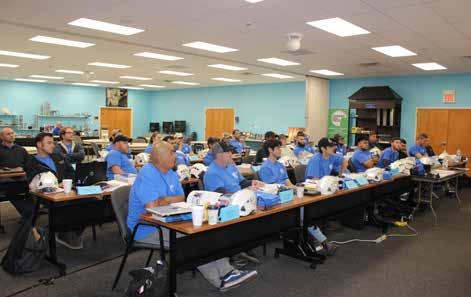


The organization is dedicated to their consumer public awareness campaign. Tucked away on Commercial Drive in the business district of Plainfield, the organization’s leaders have watched as warehouses, housing and other developments have built up around them, but haven’t been as vocal about their presence in past years.
In an effort to share with the public regarding what they do, they recently opened their doors to the Plainfield Chamber of Commerce for a tour of the 10,000-square-foot Technology Center.
“CSIA was kind to invite our members in for a networking and informational event earlier in the years,” says Brad DuBois, president and CEO of the Plainfield Chamber of Commerce. “Most folks in Plainfield don’t know they are there or what they do, but we at the chamber want to do our best to let citizens know of this great resource and look forward to more partnerships with CSIA.”
Certified technicians take pride in educating the public during routine chimney-sweep visits and try to help when they see danger lurking.
“We want people to understand how important this is for the safety of your home and your family,” Wald says. “It’s not uncommon when a chimney sweep arrives at the house to find the gas key sitting in the keyhole for the gas fireplace. All it takes is a child to turn the key or someone to bump into it to release gas in the house.”
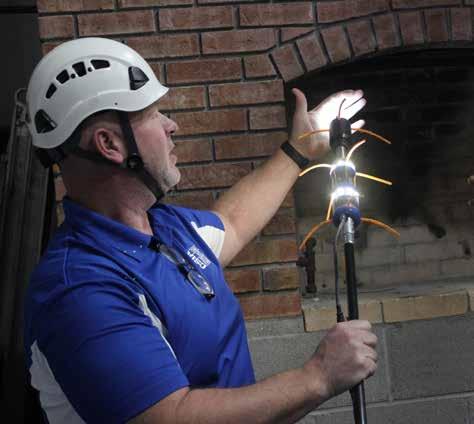
That’s right. It doesn’t matter if you have a wood-burning or gas fireplace - the dangers are similar.

“Even if you have a gas fireplace, you’re still burning something in your home,” Wald says. “Many start gas fires and don’t use the correct material. The plugs that release the gas can become clogged.”
In order to reach as many people as possible, CSIA President Tommy Nelms, a former fireman, hosts a Fireside Talk on Facebook every other Thursday evening.

He and special guests discuss topics including what size of wood should be used, where to store it and how to season it, what creosote is (the tar-like substance that builds up inside the chimney), and dangers to the home.
It may seem strange to think of fireplace safety as summer is around the corner, but Wald recommends getting your fireplace inspected and cleaned in the warmer months.
“Once winter is over, you can hire a chimney sweep much faster and get it
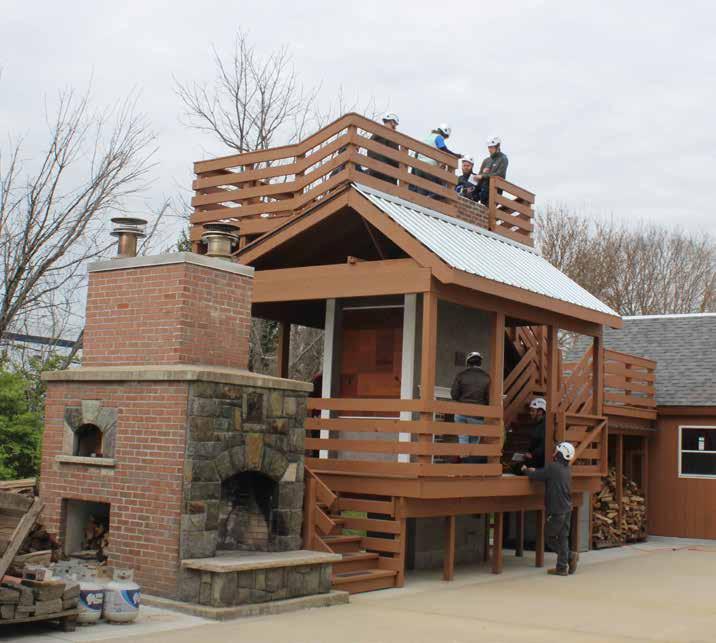
cleaned out for the next season,” Wald says. “If there are any issues, it gives you time to fix the problems. You can imagine how many calls they receive in the fall, right before the weather gets cold.”
In addition to the chimney safety industry, the CSIA also works in the dryer-vent industry - another dangerous and often disregarded area of the home. “I had a friend who bought a new dryer and didn’t have their vent cleaned out,” Wald says. “They hooked it up and it caught on fire, causing $50,000 worth of damage. We often don’t think about it,
but these are appliances in our home that need the same attention as others.”
The most important factor is keeping homes and families safe, and the CSIA is working to do their part.
“Little things can happen and can create a lot of damage, and possibly hurt your family,” Wald says. “We want to ensure that everyone with a chimney is safe.”
For more information on the CSIA, visit csia.org, or follow them on Facebook for daily tips and the Fireside Talk.











Warm weather may decide to show up one day. When that time comes, we may want to get out and travel. Some people just toss a few clothes in a suitcase, put a hold on their mail, lock the doors and head out. For those of us with pets, it’s a bit more complicated. Do we take our furry friends with us, or do we find someone to watch them?
Let’s explore the first option. What do you need to take with you? For dogs and cats, leashes and collars/harnesses are essential. A crate or carrier is a must. Cats will also need a litter box. My cat loves to travel, but she also likes to leave a very fragrant present for me not long after we get on the road. Once that deed is done, she is content to snuggle on a soft blanket and watch the world go by.
Are you bringing a bag of your pet’s food? Will you buy along the way or when you
get to your destination? My pup likes to share my food. Often when I swing through the drive-though I will get a kids meal for her. There are advantages to this. She eats when I eat, so I don’t have to make an extra stop to feed her. The downside is the outgassing that can occur. Sometimes it’s better to take the time for a proper lunch/stretch break.
Just like us, pets get bored when they are cooped up for long periods of time. Have a few toys and chews to keep them from going crazy. Their favorite blanket helps them feel safe and reminds of them home.
The distance you travel will determine what you need to bring. A two-hour trip won’t require much. A seven-day trip will require a few more supplies.
How are you traveling? By car, motorcycle, plane or ship? Your mode of transportation will determine what
room you have for supplies. I knew a guy who ordered a special carrier for his ferret so they could go on motorcycle rides together. The carrier had an extra compartment for supplies.
Does your pet like to travel? Not all birds - or dogs or cats, for that matter - are like Tweety bird, who will happily sing in his cage no matter where he is. If your pet doesn’t like the road, sea or air, it might be best to leave them at home.

Where will you be staying - a tent, travel trailer, friend or relative’s house, or hotel? Whatever your accommodations, confirm and reconfirm that your non-human travel companions are welcome and allowed at your final destination, and overnight stops along the way.
Now that we have gathered all our supplies and have our housing arranged, what are we going to do with our pets once we arrive? Will they be content to wait at the temporary house while you go
out for the day? Keep in mind that not all hotels want pets staying unattended all day. Will they join you on your daily adventures?
Make sure you add a few critter items to your backpack - food, water, bowl, treatsbefore you start your exploring each day. If you decide not to take your pet - your goldfish might be happier staying at home - where will they spend their time?
You can have a friend, neighbor or professional pet sitter swing by the house every day to check on your critters. This is a great option for pets who are most comfortable in their own home.
The second option is to board your non-human pals. Many vet clinics offer boarding for current clients. You can find a variety of boarding kennels around town. Some only take dogs, while others accept other animals. If you decide to board your furry, feathered or finned
family members, visit the facility before you drop them off. Ask questions about daily routines and the knowledge of the staff. If you aren’t allowed to tour the boarding area, you might want to consider another place.

Some kennels are simple and practical in providing your pet’s necessities. Others offer extra services like daily play groups or walks. Curbside Clips in Roachdale offers home-awayfrom-home boarding.

Visiting pets have their own apartment attached to the main house. The apartment includes a living room with a couch and TV, a dog-sized door that opens to a fenced yard, and a bedroom with soft blankets.

If your pet isn’t quite ready for a summer adventure, reach out to a professional trainer to help with socialization and manners. T&D Forever Home Training offers some expert advice for humans and pets.
Whatever you decide to do this summer, remember that time spent with your pet will create the best memories.
With the summer finally here and kids out of school, grandkids have more time to spend with their grandparents. Though many activities are fun, there can also be potential dangers. With that being said, it is important to know what to look out for while watching your grandchildren this summer.

According to the Indiana State Police, in Indiana all children under the age of 8 must be properly restrained in a child safety seat or booster seat, according to the child restraint system manufacturer’s instructions. All car seats are different, so it is best to read the instruction manual and go to a local inspection station.
Make sure you know your grandchild’s medical history, so you know if they need to take any medications and in case the child experiences a medical emergency
while in your care. If so, know how much and how frequently to provide the dose. Children aged 12 and under should not be given aspirin since it is connected to Reye syndrome, an illness that causes nausea, vomiting and behavioral changes, and also often requires treatment in a hospital. Medications should always be out of reach and out of sight of children, or stored in child-resistant containers. It is important to keep your purse or backpack away from grandchildren as well, because medications may be kept there.
Whenever your grandkid is on a bike, skateboard, rip stick or other toy, make sure they are wearing a helmet to prevent serious injury. It is recommended that children use helmets while riding bicycles to reduce the likelihood of head trauma, including traumatic brain injury and related consequences. According to the Centers for Disease Control and Prevention, it is important for kids to wear helmets until they are at least 16 years old.
Children are curious and drawn to water. Keep small children safe from any open water. Even a cooler with melted ice can be a hazard to a toddler.
A good rule of thumb is that if it can go through a toilet paper roll, it is a choking hazard. Small button-shaped batteries, like those used for hearing aids, can cause severe damage if swallowed, inhaled or put up a child’s nose. These items can cause life-threatening chemical burns as well.
Inspect your backyard for anything hazardous or poisonous. Keep the grandchildren out of the yard when you are mowing the lawn. Never let children ride on a lawnmower with you. Garages can have garden chemicals, auto products, pesticides and tools. Make sure to keep them in a locked cabinet and out of reach.
35. Fido’s greeting? 36. Variety 38. Scottish ponds
39. 2004 Jude Law role 41. Buy stuff 42. Abalone production 45. Unwelcome forecast 47. Egg cell 48. Rush job notation
DOWN
1. Engine part
2. Billboard messages
3. Confusing
4. Cry over spilled milk
5. Looks out for, maybe
6. Paleontologist’s pursuit
7. Get firm
8. Deadly poisons
9. Fertilizer ingredient

10. Suggest
11. Course guidelines?
19. Skeleton component
29. Audio effect
30. Stinger
32. Holiday help 34. Kate in “Titanic” 37. Mug 39. Holding one’s piece
Make happy
“___ chance!” 43. Declare


A dog is a man’s best friend, as the saying goes. But according to the Plainfield Police Department, he’s also man’s protector, drug sniffer, bad-guy catcher, and all-around the “goodest boy.”
At least that’s what Jocko’s collar says. Jocko is one of five K9s at Plainfield. Every K9 at the force can aid the department in nearly every objective, including chasing suspects, finding drugs, sniffing out evidence or even just connecting with the community.
While the K9 program has been around at the department for years, Deputy Chief of Police Joseph Aldridge has big plans to grow the program using a new secret weapon - shelter dogs.
“We have already identified one such dog that will be the first,” Aldridge says, referring to a former stray Malinois they named Echo. “We are the only agency in this county and probably across the state that is going in that direction.”
U.S. Marine Corps veteran and Plainfield K9 Officer Rob Prichard is a K9 Handler for the department, and is passionate about dogs and the many benefits they bring to
the department’s work.
Prichard graduated from K9 trainer school in March, spending 10 weeks completing a two-part training in Florida. His first session involved training a group of dogs. To graduate, he had to have all the dogs graduate by police standards. His second session involved helping to run the police K9 school by teaching new K9 trainees.
Now he can train dogs and handlers at the Plainfield Police Department.
There are five dogs currently working as K9s. One is recently retired and Echo is being trained currently. He was adopted
“The dogs are force multipliers for the police,” Prichard says. “We use them to locate people and evidence, and to protect officers at the scene. They’re great for public relations because everybody likes dogs.”









He points out that the K9s are also good at breaking down barriers the public may have with police officers. While some people may not want to talk to the police, they suddenly open up when the dogs come around. Alternatively, the dogs are helpful for apprehending suspects in a field or barricaded in a home.

“People often give up when they see the dog,” Prichard says. “If we’re going after a bad guy with a warrant, we knock on the door and they may tell us to go away. But once they hear that dog, they’re ready to go to jail.”
In the last three years, the K9s have aided the department in 300 criminal apprehensions, with only three of them resulting in a bite.
“They enhance our officers’ ability to protect people,” Prichard says.
Don’t mistake Hollywood movies for how K9s operate on the local force. In fact, almost everything the department does with the K9s is done while the K9s are on leashes. Dogs are very rarely set loose to attack someone, find a person or find evidence.
“The golden rule is to never send your partner into a fight you can’t win,” Prichard says. “If you’re going into the unknown, you want to be right there with them. They are not a sacrificial lamb. They’re risking just as much as you are.”
Most of the time, K9s are a type of German Shepherd and are traditionally imported from Europe. Prichard describes the process as visiting a U.S. military base to meet the imported dogs, observing demonstrations, then purchasing dogs for $10,000 to $15,000 each and bringing them back to the force.

He describes finding his beloved K9 partner Jocko on a military base.
“There were 10 to 12 dogs to choose from,” Prichard says. “The first couple didn’t like me. They had the lip curl and everything. Then there was Jocko, who rolled over and gave me his belly right away. He is just the best.”
Jocko is a well-rounded K9, focused and hard-working on the job, and a perfect connector to kids at schools and public events. Jocko and Prichard even participated in granting several wishes for Make-
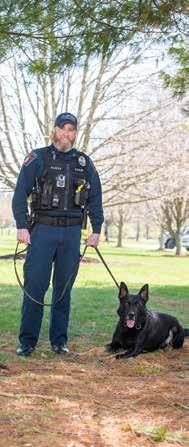

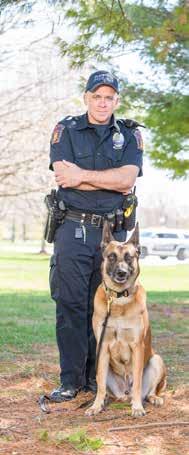


A-Wish kids who wanted to experience being a K9 police handler for a day.
Jocko lives with Prichard. In fact, all K9s live with their handlers. Prichard can’t wait to train even more dogs.


“What we are going to do is groundbreaking,” Aldridge says. “Now we can train and certify our K9s in-house, which becomes free for the agency.”
Aldridge says the police department collaborates often with the animal shelter, hosting adoption events at the school, helping with holiday dinners, and spending time highlighting how many great dogs are available for adoptions.
“These dogs have so much to give,” Prichard says. “There is such an untapped resource there. They would make phenomenal pets, but I’ve always felt if we could identify the right dogs with the right drive and personality, we can work
and develop them.”
The shelter leaders knew the force was open to training adoptable dogs, so Prichard recently got a call from them saying there was a very thin, stray and aggressive Malinois dog he may be interested in.
Prichard started working with him and quickly realized the dog, whom he named Echo, wasn’t aggressive. He was incredibly smart with unharnessed energy.
“He picked up training very quickly,” Prichard says. “The Malinois breed is notorious for being the highest level of energy. They’re phenomenal work dogs, they don’t get tired, they like problemsolving and they like human interaction.”
Echo will be fostered until he’s placed with a handler. He is currently learning criminal apprehension, tracking,
obedience and suspect detection.
“With Echo, he proves shelter dogs can become K9s,” Prichard says. “We have two more identified who have passed my initial evaluations.”
As the program expands, the goal is to add gun protection to the local school system, which means the K9 could sweep parking lots, lockers, backpacks and pockets in a proactive manner. The dog could also be trained as a therapy dog for children who have been victims of crimes or who must testify about a traumatic experience.
“This idea can work,” Aldridge says. “It starts with one. We take a dog that lived in a shelter and we’re giving him a home, a family, shelter and a purpose. The dogs are free. It’s easier on the taxpayers. It’s a win for the shelters, it’s a win for the public and it’s a win for us.”


When the family is about to grow by two feet, you’ve got a whole team ready to help you find your footing. Franciscan Health’s labor and delivery specialists take all the steps to motherhood with you – from prenatal to postnatal, and every step in between, including advanced care for high-risk pregnancies and breastfeeding support services.
Step into your new role as mom with confidence! Choose your OB/GYN today.

Fran.Care/OBNurseNav





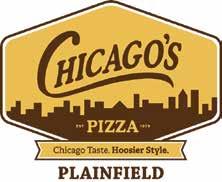












When your kids need everyday, routine primary care—for snif es, sports physicals and everything in between—you can see a highly skilled Riley pediatrician at a location close to you
When your kids need everyday, routine primary care—for snif es, sports physicals and everything in between—you can see a highly skilled Riley pediatrician at a location close to you

It’s expert pediatric primary care from Indiana’s most trusted name in healthcare for kids.
It’s expert pediatric primary care from Indiana’s most trusted name in healthcare for kids.





Extended Hours | Saturday and Same-Day Appointments | 24/7 Online Scheduling | Virtual Visits



